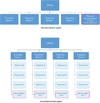SUPPORT Tools for evidence-informed health Policymaking (STP) 3: Setting priorities for supporting evidence-informed policymaking
- PMID: 20018110
- PMCID: PMC3271830
- DOI: 10.1186/1478-4505-7-S1-S3
SUPPORT Tools for evidence-informed health Policymaking (STP) 3: Setting priorities for supporting evidence-informed policymaking
Abstract
This article is part of a series written for people responsible for making decisions about health policies and programmes and for those who support these decision makers. Policymakers have limited resources for developing--or supporting the development of--evidence-informed policies and programmes. These required resources include staff time, staff infrastructural needs (such as access to a librarian or journal article purchasing), and ongoing professional development. They may therefore prefer instead to contract out such work to independent units with more suitably skilled staff and appropriate infrastructure. However, policymakers may only have limited financial resources to do so. Regardless of whether the support for evidence-informed policymaking is provided in-house or contracted out, or whether it is centralised or decentralised, resources always need to be used wisely in order to maximise their impact. Examples of undesirable practices in a priority-setting approach include timelines to support evidence-informed policymaking being negotiated on a case-by-case basis (instead of having clear norms about the level of support that can be provided for each timeline), implicit (rather than explicit) criteria for setting priorities, ad hoc (rather than systematic and explicit) priority-setting process, and the absence of both a communications plan and a monitoring and evaluation plan. In this article, we suggest questions that can guide those setting priorities for finding and using research evidence to support evidence-informed policymaking. These are: 1. Does the approach to prioritisation make clear the timelines that have been set for addressing high-priority issues in different ways? 2. Does the approach incorporate explicit criteria for determining priorities? 3. Does the approach incorporate an explicit process for determining priorities? 4. Does the approach incorporate a communications strategy and a monitoring and evaluation plan?
Figures
References
LinkOut - more resources
Full Text Sources



